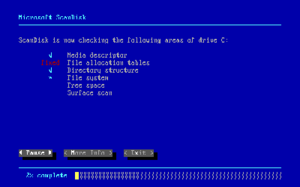 Text-based version of Microsoft ScanDisk running on Windows 98 | |
| Other names | ScanDisk |
|---|---|
| Developer(s) | Microsoft |
| Initial release | 1993 |
| Operating system | MS-DOS 6.2 and Windows 9x |
| Type | Utility software |
| License | Proprietary commercial software |
Microsoft ScanDisk (also called ScanDisk) is a diagnostic utility program included in MS-DOS and Windows 9x. It checks and repairs file systems errors on a disk drive, while the system starts.
Overview
[edit]The program was first introduced in MS-DOS 6.2[1] and succeeded its simpler predecessor, CHKDSK. It included a more user-friendly interface than CHKDSK, more configuration options,[2][3] and the ability to detect and (if possible) recover from physical errors on the disk. This replaced and improved upon the limited ability offered by the MS-DOS recover utility.[4] Unlike CHKDSK, ScanDisk would also repair crosslinked files.[5]
In Windows 95 onwards, ScanDisk also had a graphical user interface, although the text-based user interface continued to be available for use in single-tasking ("DOS") mode.[6][7]
However, ScanDisk cannot check NTFS disk drives, and therefore it is unavailable for computers that may be running NT based (including Windows 2000, Windows XP, etc.) versions of Windows; for the purpose, a newer CHKDSK is provided instead.
On Unix-like systems, there are tools like fsck_msdosfs[8] and dosfsck to do the same task.
See also
[edit]References
[edit]- ^ Wolverton, Van (2003). Running MS-DOS Version 6.22 (20th Anniversary Edition), 6th Revised edition. Microsoft Press. ISBN 0-7356-1812-7.
- ^ "ScanDisk command-line options". Microsoft Support. Microsoft Corporation. 2007-01-23. Retrieved 24 December 2011.
- ^ "MS-DOS 6.2 ScanDisk.INI". Microsoft Support. Microsoft Corporation. 2003-10-14. Retrieved 24 December 2011.
- ^ "What Does RECOVER Do? (Revision 3.0)". Microsoft Support. Microsoft Corporation. 25 November 2003. Retrieved 24 December 2011.
- ^ "How to Fix Cross-linked Files (Revision: 2.0)". Microsoft Support. Microsoft Corporation. 10 May 2003. Retrieved 24 December 2011.
If you are running MS-DOS 6.2 or later, run ScanDisk, instead of [~snip~]
- ^ "Windows 95 Documentation". Microsoft TechNet. Microsoft Corporation. 1996-03-03. Retrieved 24 December 2011.
- ^ "Description of ScanDisk for Windows (Scandskw.exe) in Windows 98/Me (Revision: 1.3)". Microsoft Support. Microsoft Corporation. 23 January 2007. Retrieved 24 December 2011.
- ^ "FSCK_MSDOSFS". FreeBSD System Manager's Manual. The FreeBSD Project. 13 August 1995. Retrieved 24 December 2011.
Further reading
[edit]- Cooper, Jim (2001). Special Edition Using MS-DOS 6.22, Third Edition. Que Publishing. ISBN 978-0789725738.
- Stinson, Craig (1998). "ch. 16: Optimizing, Maintaining, and Troubleshooting". Running Microsoft Windows 98. Redmond, Washington: Microsoft Press. ISBN 1-57231-681-0. Retrieved 24 December 2011.
Well, that’s interesting to know that Psilotum nudum are known as whisk ferns. Psilotum nudum is the commoner species of the two. While the P. flaccidum is a rare species and is found in the tropical islands. Both the species are usually epiphytic in habit and grow upon tree ferns. These species may also be terrestrial and grow in humus or in the crevices of the rocks.
View the detailed Guide of Psilotum nudum: Detailed Study Of Psilotum Nudum (Whisk Fern), Classification, Anatomy, Reproduction